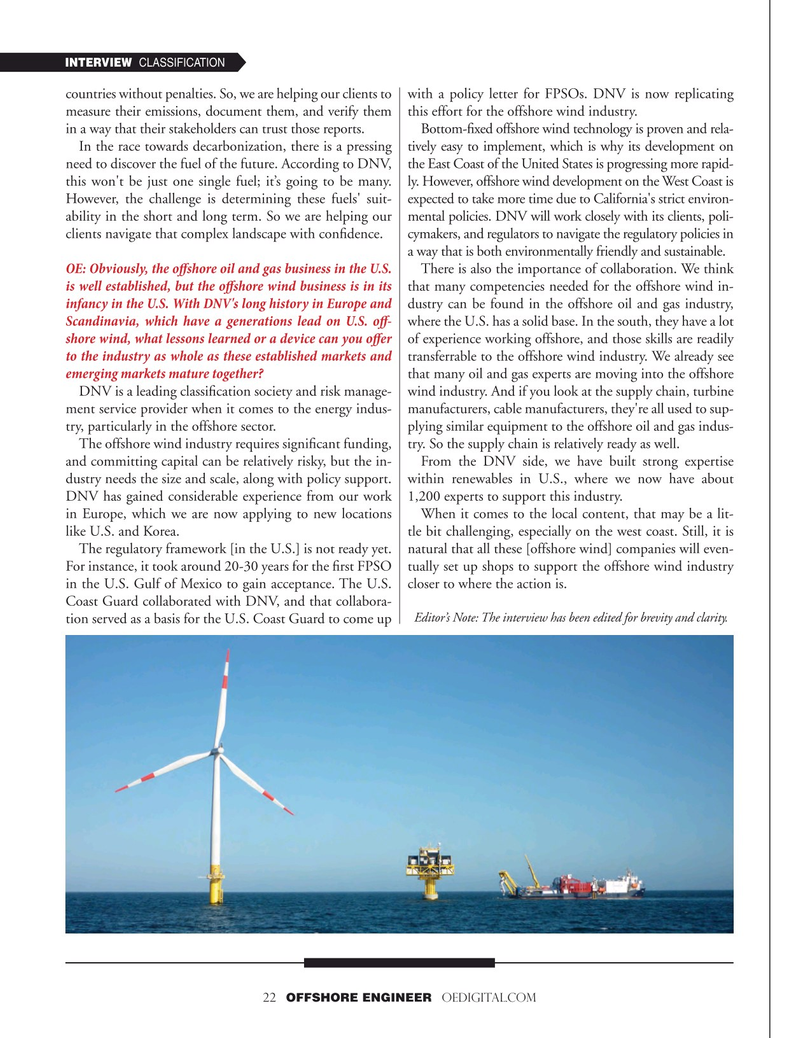
Page 22: of Offshore Engineer Magazine (Mar/Apr 2023)
Read this page in Pdf, Flash or Html5 edition of Mar/Apr 2023 Offshore Engineer Magazine
INTERVIEW CLASSIFICATION countries without penalties. So, we are helping our clients to with a policy letter for FPSOs. DNV is now replicating measure their emissions, document them, and verify them this effort for the offshore wind industry.
in a way that their stakeholders can trust those reports. Bottom-fxed offshore wind technology is proven and rela-
In the race towards decarbonization, there is a pressing tively easy to implement, which is why its development on need to discover the fuel of the future. According to DNV, the East Coast of the United States is progressing more rapid- this won't be just one single fuel; it’s going to be many. ly. However, offshore wind development on the West Coast is
However, the challenge is determining these fuels' suit- expected to take more time due to California's strict environ- ability in the short and long term. So we are helping our mental policies. DNV will work closely with its clients, poli- clients navigate that complex landscape with confdence. cymakers, and regulators to navigate the regulatory policies in a way that is both environmentally friendly and sustainable.
OE: Obviously, the ofshore oil and gas business in the U.S. There is also the importance of collaboration. We think is well established, but the ofshore wind business is in its that many competencies needed for the offshore wind in- infancy in the U.S. With DNV's long history in Europe and dustry can be found in the offshore oil and gas industry,
Scandinavia, which have a generations lead on U.S. of- where the U.S. has a solid base. In the south, they have a lot shore wind, what lessons learned or a device can you ofer of experience working offshore, and those skills are readily to the industry as whole as these established markets and transferrable to the offshore wind industry. We already see emerging markets mature together? that many oil and gas experts are moving into the offshore
DNV is a leading classifcation society and risk manage- wind industry. And if you look at the supply chain, turbine ment service provider when it comes to the energy indus- manufacturers, cable manufacturers, they're all used to sup- try, particularly in the offshore sector. plying similar equipment to the offshore oil and gas indus-
The offshore wind industry requires signifcant funding, try. So the supply chain is relatively ready as well.
and committing capital can be relatively risky, but the in- From the DNV side, we have built strong expertise dustry needs the size and scale, along with policy support. within renewables in U.S., where we now have about
DNV has gained considerable experience from our work 1,200 experts to support this industry.
in Europe, which we are now applying to new locations When it comes to the local content, that may be a lit- like U.S. and Korea. tle bit challenging, especially on the west coast. Still, it is
The regulatory framework [in the U.S.] is not ready yet. natural that all these [offshore wind] companies will even-
For instance, it took around 20-30 years for the frst FPSO tually set up shops to support the offshore wind industry in the U.S. Gulf of Mexico to gain acceptance. The U.S. closer to where the action is.
Coast Guard collaborated with DNV, and that collabora-
Editor’s Note: The interview has been edited for brevity and clarity.
tion served as a basis for the U.S. Coast Guard to come up 22 OFFSHORE ENGINEER OEDIGITAL.COM

 21
21

 23
23